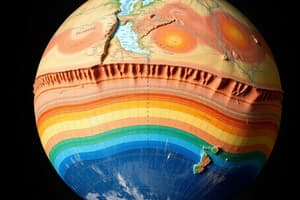Podcast
Questions and Answers
How are large crystals formed in igneous rocks?
How are large crystals formed in igneous rocks?
- From rapid cooling
- From slow cooling (correct)
- From transportation
- From weathering
What type of rocks transform under extreme pressure and temperature without melting?
What type of rocks transform under extreme pressure and temperature without melting?
- Metamorphic rocks (correct)
- Igneous rocks
- Sedimentary rocks
- Intrusive rocks
How are laccoliths and lopoliths formed?
How are laccoliths and lopoliths formed?
- By magma intrusion between rock layers (correct)
- By weathering
- By erosion
- By volcanic eruptions
What distinguishes sills from dykes in their formation?
What distinguishes sills from dykes in their formation?
Which type of rock is known for formations like tors?
Which type of rock is known for formations like tors?
How do sedimentary rock landforms differ from karst landscapes?
How do sedimentary rock landforms differ from karst landscapes?
Which layer of the Earth is directly beneath the crust?
Which layer of the Earth is directly beneath the crust?
What marks the boundary between the Earth's crust and mantle?
What marks the boundary between the Earth's crust and mantle?
Which layer of the Earth is primarily composed of nickel (Ni) and iron (Fe)?
Which layer of the Earth is primarily composed of nickel (Ni) and iron (Fe)?
What is the physical state of the Earth's inner core?
What is the physical state of the Earth's inner core?
Which layer of the Earth is about 1,200 km thick?
Which layer of the Earth is about 1,200 km thick?
What is the temperature range that the mantle of the Earth can reach?
What is the temperature range that the mantle of the Earth can reach?
What is the physical state of the Earth's outer core?
What is the physical state of the Earth's outer core?
Which layer of the Earth remains solid despite extreme heat?
Which layer of the Earth remains solid despite extreme heat?
What marks the boundary between the Earth's crust and mantle?
What marks the boundary between the Earth's crust and mantle?
At what temperature can the mantle of the Earth reach?
At what temperature can the mantle of the Earth reach?
Which layer of the Earth is divided into tectonic plates?
Which layer of the Earth is divided into tectonic plates?
How are dykes and sills different in their orientation?
How are dykes and sills different in their orientation?
What characterizes the formation of batholiths?
What characterizes the formation of batholiths?
What leads to the formation of karst landscapes in limestone?
What leads to the formation of karst landscapes in limestone?
What distinguishes laccoliths from lopoliths?
What distinguishes laccoliths from lopoliths?
What results in the formation of metamorphic rocks?
What results in the formation of metamorphic rocks?
What property of the Earth's inner core prevents it from melting despite extreme heat?
What property of the Earth's inner core prevents it from melting despite extreme heat?
Which layer of the Earth is characterized by being capable of flow due to its plastic-like rock composition?
Which layer of the Earth is characterized by being capable of flow due to its plastic-like rock composition?
What is the primary composition of the Earth's outer core that contributes to its liquid state?
What is the primary composition of the Earth's outer core that contributes to its liquid state?
Which layer of the Earth is found beneath the Mohorovičić discontinuity (Moho)?
Which layer of the Earth is found beneath the Mohorovičić discontinuity (Moho)?
What is the approximate thickness of the Earth's mantle?
What is the approximate thickness of the Earth's mantle?
Which layer of the Earth marks the division into tectonic plates that float over the semi-fluid upper mantle?
Which layer of the Earth marks the division into tectonic plates that float over the semi-fluid upper mantle?
At what temperature can the outer core of the Earth reach due to extreme temperatures?
At what temperature can the outer core of the Earth reach due to extreme temperatures?
Which layer of the Earth is composed of solid but plastic-like rock that can flow?
Which layer of the Earth is composed of solid but plastic-like rock that can flow?
What determines the crystal size within an igneous rock?
What determines the crystal size within an igneous rock?
How do dykes differ from sills in their orientation?
How do dykes differ from sills in their orientation?
What geological process leads to the formation of sedimentary rocks?
What geological process leads to the formation of sedimentary rocks?
What landform is characteristic of limestone karst landscapes?
What landform is characteristic of limestone karst landscapes?
Which type of rock undergoes transformation under extreme pressure and heat without melting?
Which type of rock undergoes transformation under extreme pressure and heat without melting?
How do laccoliths differ from lopoliths in their formation?
How do laccoliths differ from lopoliths in their formation?
What distinguishes intrusive igneous activity from extrusive igneous activity?
What distinguishes intrusive igneous activity from extrusive igneous activity?
What is the key factor that influences the resistance to erosion and permeability of landforms?
What is the key factor that influences the resistance to erosion and permeability of landforms?
What is the maximum thickness of the Earth's crust?
What is the maximum thickness of the Earth's crust?
Which layer of the Earth is primarily composed of nickel (Ni) and iron (Fe)?
Which layer of the Earth is primarily composed of nickel (Ni) and iron (Fe)?
What is the approximate maximum temperature that the mantle of the Earth can reach?
What is the approximate maximum temperature that the mantle of the Earth can reach?
Which layer of the Earth marks the boundary between the mantle and the crust?
Which layer of the Earth marks the boundary between the mantle and the crust?
What causes the inner core of the Earth to remain solid despite extreme heat?
What causes the inner core of the Earth to remain solid despite extreme heat?
Which layer of the Earth is characterized by being able to flow due to its plastic-like rock composition?
Which layer of the Earth is characterized by being able to flow due to its plastic-like rock composition?
What is the depth range of the mantle, extending downward from beneath the crust?
What is the depth range of the mantle, extending downward from beneath the crust?
How thick is the outer core of the Earth?
How thick is the outer core of the Earth?
Which layer of the Earth forms the upper part of the lithosphere?
Which layer of the Earth forms the upper part of the lithosphere?
What is characteristic of the Earth's outer core due to the extremely high temperatures it experiences?
What is characteristic of the Earth's outer core due to the extremely high temperatures it experiences?
What is a key factor influencing the formation of large crystals in igneous rocks?
What is a key factor influencing the formation of large crystals in igneous rocks?
What characteristic distinguishes laccoliths from lopoliths?
What characteristic distinguishes laccoliths from lopoliths?
What geological process forms dykes and sills in intrusive igneous activity?
What geological process forms dykes and sills in intrusive igneous activity?
What type of rocks are most likely to exhibit karst landscapes?
What type of rocks are most likely to exhibit karst landscapes?
What factor primarily determines the resistance to erosion and permeability of landforms?
What factor primarily determines the resistance to erosion and permeability of landforms?
Which type of rock is characterized by the alteration of mineral composition and structure under extreme pressure and temperature?
Which type of rock is characterized by the alteration of mineral composition and structure under extreme pressure and temperature?
What distinguishes sills from dykes in intrusive igneous activity?
What distinguishes sills from dykes in intrusive igneous activity?
What is a distinguishing feature of batholiths in the rock cycle?
What is a distinguishing feature of batholiths in the rock cycle?
How do sedimentary rock landforms differ from igneous rock landforms?
How do sedimentary rock landforms differ from igneous rock landforms?
What is a key factor influencing the formation of sedimentary rocks?
What is a key factor influencing the formation of sedimentary rocks?
Which process leads to the formation of tors as described in the text?
Which process leads to the formation of tors as described in the text?



